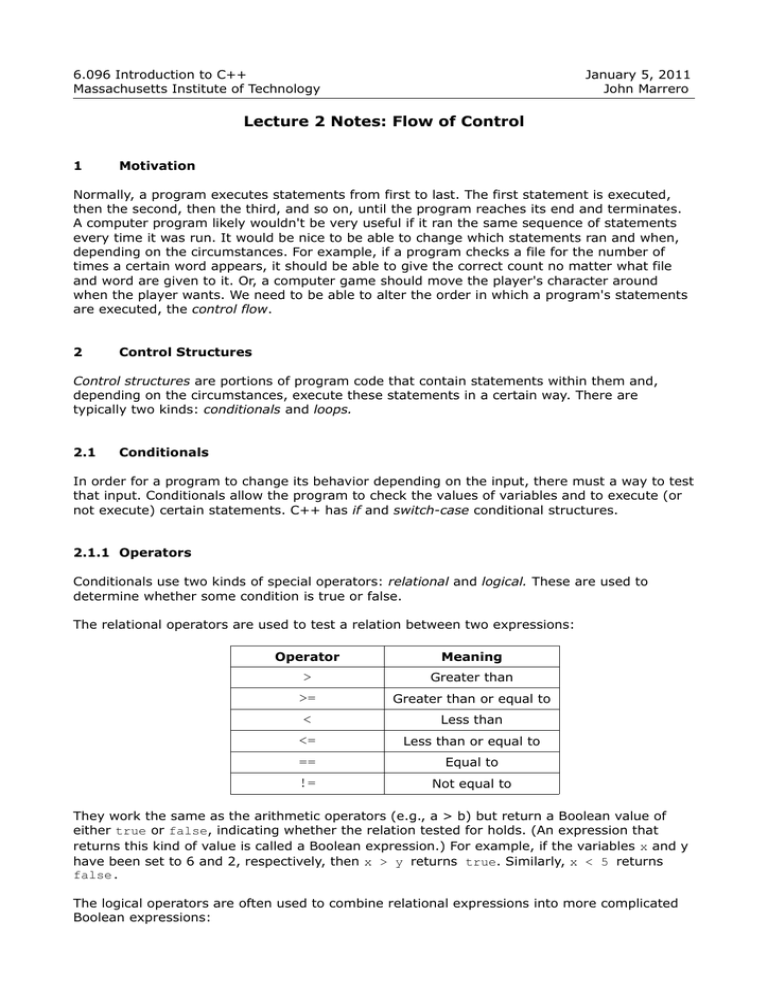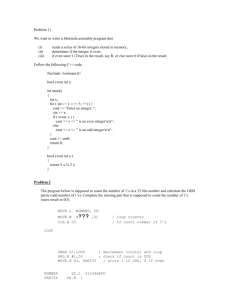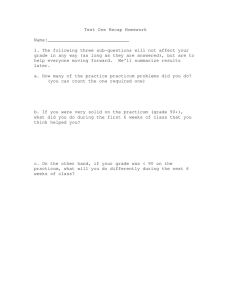Document 13383790
advertisement

6.096 Introduction to C++
Massachusetts Institute of Technology
January 5, 2011
John Marrero
Lecture 2 Notes: Flow of Control
1
Motivation
Normally, a program executes statements from first to last. The first statement is executed,
then the second, then the third, and so on, until the program reaches its end and terminates.
A computer program likely wouldn't be very useful if it ran the same sequence of statements
every time it was run. It would be nice to be able to change which statements ran and when,
depending on the circumstances. For example, if a program checks a file for the number of
times a certain word appears, it should be able to give the correct count no matter what file
and word are given to it. Or, a computer game should move the player's character around
when the player wants. We need to be able to alter the order in which a program's statements
are executed, the control flow.
2
Control Structures
Control structures are portions of program code that contain statements within them and,
depending on the circumstances, execute these statements in a certain way. There are
typically two kinds: conditionals and loops.
2.1
Conditionals
In order for a program to change its behavior depending on the input, there must a way to test
that input. Conditionals allow the program to check the values of variables and to execute (or
not execute) certain statements. C++ has if and switch-case conditional structures.
2.1.1 Operators
Conditionals use two kinds of special operators: relational and logical. These are used to
determine whether some condition is true or false.
The relational operators are used to test a relation between two expressions:
Operator
Meaning
>
Greater than
>=
Greater than or equal to
<
Less than
<=
Less than or equal to
==
Equal to
!=
Not equal to
They work the same as the arithmetic operators (e.g., a > b) but return a Boolean value of
either true or false, indicating whether the relation tested for holds. (An expression that
returns this kind of value is called a Boolean expression.) For example, if the variables x and y
have been set to 6 and 2, respectively, then x > y returns true. Similarly, x < 5 returns
false.
The logical operators are often used to combine relational expressions into more complicated
Boolean expressions:
Operator
Meaning
&&
and
||
or
!
not
The operators return true or false, according to the rules of logic:
a
b
a && b
true
true
true
true
false
false
false
true
false
false
false
false
a
b
a || b
true
true
true
true
false
true
false
true
true
false
false
false
The ! operator is a unary operator, taking only one argument and negating its value:
a
!a
true
false
false
true
Examples using logical operators (assume x = 6 and y = 2):
!(x > 2) →
(x > y) &&
(x < y) &&
(x < y) ||
false
(y > 0) → true
(y > 0) → false
(y > 0) → true
Of course, Boolean variables can be used directly in these expressions, since they hold true
and false values. In fact, any kind of value can be used in a Boolean expression due to a
quirk C++ has: false is represented by a value of 0 and anything that is not 0 is true. So,
“Hello, world!” is true, 2 is true, and any int variable holding a non-zero value is true. This
means !x returns false and x && y returns true!
2.1.2 if, if-else and else if
The if conditional has the form:
if(condition)
{
statement1
statement2
…
}
The condition is some expression whose value is being tested. If the condition resolves to a
value of true, then the statements are executed before the program continues on. Otherwise,
the statements are ignored. If there is only one statement, the curly braces may be omitted,
giving the form:
if(condition)
statement
The if-else form is used to decide between two sequences of statements referred to as blocks:
if(condition)
{
statementA1
statementA2
…
}
else
{
statementB1
statementB2
…
}
If the condition is met, the block corresponding to the if is executed. Otherwise, the block
corresponding to the else is executed. Because the condition is either satisfied or not, one of
the blocks in an if-else must execute. If there is only one statement for any of the blocks, the
curly braces for that block may be omitted:
if(condition)
statementA1
else
statementB1
The else if is used to decide between two or more blocks based on multiple conditions:
if(condition1)
{
statementA1
statementA2
…
}
else if(condition2)
{
statementB1
statementB2
…
}
If condition1 is met, the block corresponding to the if is executed. If not, then only if
condition2 is met is the block corresponding to the else if executed. There may be more
than one else if, each with its own condition. Once a block whose condition was met is
executed, any else ifs after it are ignored. Therefore, in an if-else-if structure, either one or
no block is executed.
An else may be added to the end of an if-else-if. If none of the previous conditions are met,
the else block is executed. In this structure, one of the blocks must execute, as in a normal ifelse.
Here is an example using these control structures:
1
2
3
4
5
6
7
8
9
10
11
12
13
14
15
16
#include <iostream>
using namespace std;
int main() {
int x = 6;
int y = 2;
if(x > y)
cout << “x is greater than y\n”;
else if(y > x)
cout << “y is greater than x\n”;
else
cout << “x and y are equal\n”;
}
return 0;
The output of this program is x is greater than y. If we replace lines 5 and 6 with
int x = 2;
int y = 6;
then the output is y is greater than x. If we replace the lines with
int x = 2;
int y = 2;
then the output is x and y are equal.
2.1.3 switch-case
The switch-case is another conditional structure that may or may not execute certain
statements. However, the switch-case has peculiar syntax and behavior:
switch(expression)
{
case constant1:
statementA1
statementA2
...
break;
case constant2:
statementB1
statementB2
...
break;
...
default:
statementZ1
statementZ2
...
}
The switch evaluates expression and, if expression is equal to constant1, then the
statements beneath case constant 1: are executed until a break is encountered. If
expression is not equal to constant1, then it is compared to constant2. If these are equal,
then the statements beneath case constant 2: are executed until a break is encountered. If
not, then the same process repeats for each of the constants, in turn. If none of the constants
match, then the statements beneath default: are executed.
Due to the peculiar behavior of switch-cases, curly braces are not necessary for cases where
there is more than one statement (but they are necessary to enclose the entire switch-case).
switch-cases generally have if-else equivalents but can often be a cleaner way of
expressing the same behavior.
Here is an example using switch-case:
1
2
3
4
5
6
7
8
9
10
11
12
13
14
15
16
17
18
19
20
#include <iostream>
using namespace std;
int main() {
int x = 6;
switch(x) {
case 1:
cout << “x is 1\n”;
break;
case 2:
case 3:
cout << "x is 2 or 3";
break;
default:
cout << "x is not 1, 2, or 3";
}
}
return 0;
This program will print x is not 1, 2, or 3. If we replace line 5 with int x = 2; then the
program will print x is 2 or 3.
2.2
Loops
Conditionals execute certain statements if certain conditions are met; loops execute certain
statements while certain conditions are met. C++ has three kinds of loops: while, do-while,
and for.
2.2.1 while and do-while
The while loop has a form similar to the if conditional:
while(condition)
{
statement1
statement2
…
}
As long as condition holds, the block of statements will be repeatedly executed. If there is only
one statement, the curly braces may be omitted. Here is an example:
1
2
3
4
5
6
7
8
#include <iostream>
using namespace std;
int main() {
int x = 0;
while(x < 10)
x = x + 1;
9
10
11
12
13 }
cout << “x is “ << x << “\n”;
return 0;
This program will print x is 10.
The do-while loop is a variation that guarantees the block of statements will be executed at
least once:
do
{
statement1
statement2
…
}
while(condition);
The block of statements is executed and then, if the condition holds, the program returns to
the top of the block. Curly braces are always required. Also note the semicolon after the while
condition.
2.2.2 for
The for loop works like the while loop but with some change in syntax:
for(initialization; condition; incrementation)
{
statement1
statement2
…
}
The for loop is designed to allow a counter variable that is initialized at the beginning of the
loop and incremented (or decremented) on each iteration of the loop. Curly braces may be
omitted if there is only one statement. Here is an example:
1
2
3
4
5
6
7
8
9
10
#include <iostream>
using namespace std;
int main() {
for(int x = 0; x < 10; x = x + 1)
cout << x << “\n”;
return 0;
}
This program will print out the values 0 through 9, each on its own line.
If the counter variable is already defined, there is no need to define a new one in the
initialization portion of the for loop. Therefore, it is valid to have the following:
1
2
3
4
5
6
7
8
9
10
11
#include <iostream>
using namespace std;
int main() {
int x = 0;
for(; x < 10; x = x + 1)
cout << x << “\n”;
return 0;
}
Note that the first semicolon inside the for loop's parentheses is still required.
A for loop can be expressed as a while loop and vice-versa. Recalling that a for loop has the
form
for(initialization; condition; incrementation)
{
statement1
statement2
…
}
we can write an equivalent while loop as
initialization
while(condition)
{
statement1
statement2
…
incrementation
}
Using our example above,
1
2
3
4
5
6
7
8
9
10
#include <iostream>
using namespace std;
int main() {
for(int x = 0; x < 10; x = x + 1)
cout << x << “\n”;
return 0;
}
is converted to
1
2
3
4
5
6
7
8
9
10
11
12
13
#include <iostream>
using namespace std;
int main() {
int x = 0;
while(x < 10) {
cout << x << “\n”;
x = x + 1;
}
return 0;
}
The incrementation step can technically be anywhere inside the statement block, but it is good
practice to place it as the last step, particularly if the previous statements use the current
value of the counter variable.
2.3
Nested Control Structures
It is possible to place ifs inside of ifs and loops inside of loops by simply placing these
structures inside the statement blocks. This allows for more complicated program behavior.
Here is an example using nesting if conditionals:
1
2
3
4
5
6
7
8
9
10
11
12
13
14
15
16
17
18
#include <iostream>
using namespace std;
int main() {
int x = 6;
int y = 0;
if(x > y) {
cout << “x
if(x == 6)
cout
else
cout
} else
cout << “x
}
is greater than y\n”;
<< “x is equal to 6\n”;
<< “x is not equalt to 6\n”;
is not greater than y\n”;
return 0;
This program will print x is greater than y on one line and then x is equal to 6 on the
next line.
Here is an example using nested loops:
1
2
3
4
5
6
7
8
9
10
11
12
#include <iostream>
using namespace std;
int main() {
for(int x = 0; x < 4; x = x + 1) {
for(int y = 0; y < 4; y = y + 1)
cout << y;
cout << “\n”;
}
return 0;
}
This program will print four lines of 0123.
MIT OpenCourseWare
http://ocw.mit.edu
6.096 Introduction to C++
January (IAP) 2011
For information about citing these materials or our Terms of Use, visit: http://ocw.mit.edu/terms.





